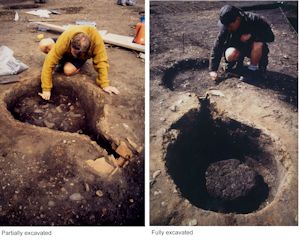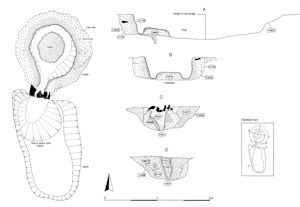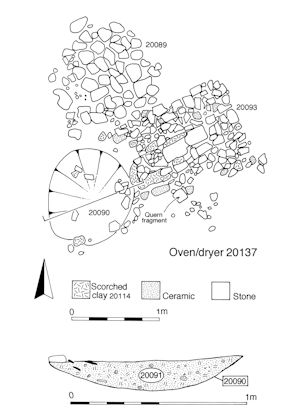
Although the majority of the OA50 interior seems to be occupied only by pitting, the presence of occasional structures indicative of manufacturing and/or processing activity suggests that this now peripheral, and perhaps largely uninhabited, part of the settlement is used for such purposes - much like parts of the Northern hinterland closest to the settlement in Period 4 (Figure 188).


Feature 14858 is the circular construction cut of an East Anglian Wattisford-type kiln, some 1.3m in diameter and 0.4m deep. The clay walls of the kiln are built up against its sides. The kiln itself comprises a firing chamber of c. 0.9m diameter, on the floor of which is a central pedestal roughly 0.5m diameter and 0.15m high. Both chamber floor and pedestal slope gently down towards a short flue located on the south-west side of the structure (possibly the product of slumping into underlying pit fills). The integral flue is also constructed of clay, with an exceptionally narrow channel (0.22m at the mouth, narrowing to 0.14m at its narrowest point), and capped with a large tile fragment (Figures 189, 190). The flue opens out into a re-cut sequence of stoke pits 14655, 14744 and 14809 - presumably an indication of the kiln's intensive use.

Pottery assemblages from the kiln and stoke-hole fills date to the late 3rd to early 4th century AD. The kiln post-dates pit 14992 (Group 717), which contains Late Roman shell-tempered ware, and is therefore almost certainly 4th century. However, attempts to determine a date of last firing by archaeomagnetic techniques have produced a date range of either AD 150-210 or AD 270-400; clearly, the latter seems most appropriate (see 'Archaeomagnetic analysis').
The floor of the kiln chamber is overlain by deposits that probably relate to the final use and initial disuse of the structure (Group 715). These comprise a thick ash layer (14621), and a deposit of pottery sherds (14591) which include spalled greyware waster sherds. These deposits confirm that the kiln is used for pottery production.
The upper fills of the chamber and those of the stoke-holes (14525, 14539, 14551 Group 716) consist largely of disturbed and broken scorched clay fragments derived from the structure of the kiln itself, along with general rubbish.

Oven/drying floor 20137 (Group 721) is located in the north-west of Open Area 50, close to the former line of Road 3. A shallow construction cut (20137) contains a foundation (20092), extending over an area 1.4m by 1.2m, constructed of tile, septaria, quern and storage jar fragments over which a clayey levelling deposit (20114) has been laid. A tile-lined flue (20093) has been built over this base and packed around with further stone and quern fragments on three sides (Figure 201). The south-west end of the flue opens out onto shallow circular pit 20090, interpreted as a stoke-hole. Abutting the west side of the flue structure is another rectangular (1.4m by 1.3m) arrangement of stone (mainly septaria) and tile, probably the foundation for a drying floor, originally indirectly heated via the adjacent flue. Late 4th-century pottery came from stoke-hole 20090 and other parts of the structure, albeit probably being more indicative of the date of its disuse.
The structure has clearly been exposed to significant heat during its lifetime and its clay elements (and much of the stone) are baked red and fire-cracked, particularly in the area of the flue. The stoke-hole fill contains collapse debris from the superstructure, but no significant amounts of charcoal or other burnt organic remains.
Internet Archaeology is an open access journal based in the Department of Archaeology, University of York. Except where otherwise noted, content from this work may be used under the terms of the Creative Commons Attribution 3.0 (CC BY) Unported licence, which permits unrestricted use, distribution, and reproduction in any medium, provided that attribution to the author(s), the title of the work, the Internet Archaeology journal and the relevant URL/DOI are given.
Terms and Conditions | Legal Statements | Privacy Policy | Cookies Policy | Citing Internet Archaeology
Internet Archaeology content is preserved for the long term with the Archaeology Data Service. Help sustain and support open access publication by donating to our Open Access Archaeology Fund.